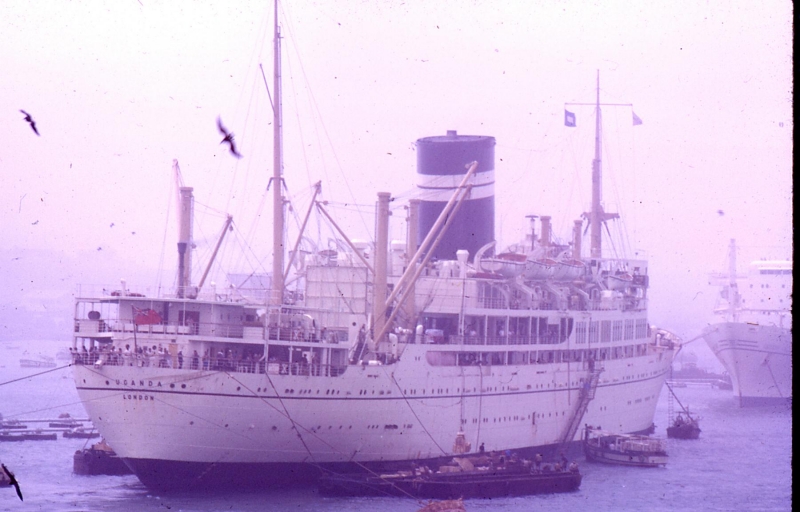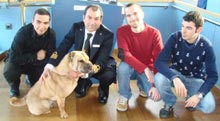fonte celeste:
SS Uganda Operator: British-India Steam Navigation Company Peninsular and Oriental Steam Navigation Company In service: 1952 Out of service: 1986 Fate: Broken up, 1992 General characteristics Type: Passenger liner / Cruise ship / Hospital ship / Troopship Tonnage: 14,430 gross register tons (GRT) Propulsion: 2 steam turbines, 12,300 hp (9,172 kW) Speed: 19 knots (35 km/h; 22 mph) SS Uganda was a passenger liner, then cruise ship, hospital ship and troop ship between 1952 and 1986. -------------------------***-------------------- Passenger liner Initially Uganda operated as a liner of the British-India Steam Navigation Company (BI), between London and East Africa, calling at Gibraltar, Naples, Port Said, Aden, Mombasa, Dar-es-Salaam and Tanga, between 1952 and 1967. The Uganda's sister ship was the SS Kenya, which continued on the East Africa route until 1969. The round trip took about 60 days. When the Suez Canal was closed, which happened twice due to warfare in 1956/1957 and from 1967, the route of the ships was Gibraltar, Las Palmas de Gran Canaria, Cape Town, Durban and East Africa. ------------------------***--------------------- Cruise ship When made redundant on the East Africa route, Uganda was converted to an educational cruise ship at Howaldtswerke-Deutsche Werft at Hamburg. Her passenger capacity leapt from 300 to 1200 and tonnage increased to 16,607 tons. In her new role she sailed her maiden voyage on 27 February 1968 and delighted school children, their teachers, passengers and crew for 14 years cruising mainly Scandinavia and the Mediterranean, together with her sister ship SS Nevasa until 1974 when Nevasa was withdrawn and scrapped - Uganda (known as the "UgTug" in the crew bar) ploughed on. By this time, the British-India Steam Navigation Company had been totally absorbed into the Peninsular and Oriental Steam Navigation Company, but, uniquely within the P&O fleet, Uganda retained her BI livery. White hull with a black band, black funnel with two white bands. As a panacea to her owners, she deigned to fly the P&O house flag, but a walk through her public rooms and a visit to the bridge continued to remind one of the days of the British Raj, not least for her first class passengers - who preferred her gentle cruising style to that of her more rowdy younger sisters like SS Oriana and SS Canberra - continuing to tap a foot to the gentle rhythms of the resident four-piece band. ---------------------------***------------------ Hospital and troop ship In 1982 the ship served as a hospital ship in the Falklands War with the affectionate call sign of "Mother Hen". She was called up to military duty while cruising - discharging her bemused passengers of school children, who were on an educational cruise, in Naples. When the Uganda docked in Naples, reporters turned up their microphones to hear a ship full of school children singing "Rule, Britannia!". The Uganda then set off for the South Atlantic after a three-day refit in Gibraltar. She returned to Southampton to a hero's welcome on 9 August 1982. After a refit in North Shields (the games deck windows never did close properly again after having Sea King helicopters landing on the quoits court), the ship returned to the familiar relaxed pattern of educational cruising again, but only for a few months as in January 1983 she took the Queen's shilling a second time and returned to duty as a troop ship serving between Ascension Island and the Falkland Islands. --------------------------***------------------- Final voyage Two years later, she was laid up, rusting, in the River Fal and despite efforts to keep her steaming was eventually sold for scrap and, rebadged as the SS Triton, taken on her final voyage to Taiwan (no school children aboard this time - and a crew of just 21) where she anchored awaiting breaking. She was driven ashore by Typhoon Wayne on 22 August 1986 near Kaohsiung, Taiwan and there she lay until broken up in 1992. The ship's original tonnage was 14,430 gross and she was fitted with two steam turbines developing 12,300 horse power. On trials her top speed was slightly over 19 knots. -----------------------------------------------------------------------------------------Rgds |

















